

The Christian converts who are setting fire to sacred Aboriginal objects. Updated earlier today at 1:59amFri 20 Sep 2019, 1:59am Christian missionaries are causing a fresh wave of upset in outback Australia, promising to bring people back from the dead, and promoting the idea traditional Aboriginal culture is a type of devil worship.
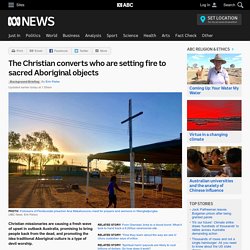
Key points: Christian converts in Wangkatjungka burned sacred objectsA preacher who has lived in the community says Aboriginal traditions are "all from the devil"Senator Pat Dodson describes some preachers as a "type of virus" An investigation by Background Briefing has uncovered dramatic scenes in the Kimberley region, where Aboriginal followers of a Tongan-born preacher have set fire to artefacts considered sacred by many local elders, and dismantled and burned a spiritual law ground. The approach of some recently arrived evangelists has been slammed by some Aboriginal leaders, including Labor senator Pat Dodson. "They are a type of virus that has really got no credibility," he said.
First Australians – Episode 1, They Have Come to Stay (2008) clip 3 on ASO - Australia's audio and visual heritage online. Clip description Narrator Rachel Perkins and interviewees Emeritus Scholar Inga Clendinnen and Associate Professor James Kohen impart the story of a cross-cultural relationship between Lieutenant Dawes and Aboriginal woman, Patyegarang.
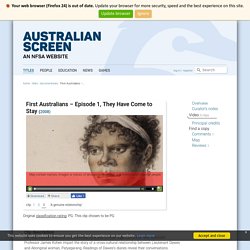
Readings of Dawes’s diaries reveal their conversations. Curator’s notes This account of early cultural exchange is very touching. It said that Lieutenant Dawes ‘met with the first Australians on their own terms’ and it is perhaps because of this that he was able to form a trusting relationship with Patyegarang. However, it does not overshadow the fact that more equal and mutually beneficial relationships were possible in this time of conflict and uncertainty. First Australians – Episode 1, They Have Come to Stay (2008) clip 2 on ASO - Australia's audio and visual heritage online. Clip description On 25 January 1788 the First Fleet enters Sydney Harbour.
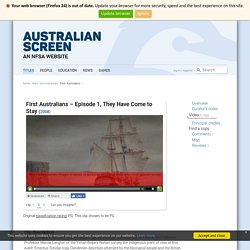
First Australians – Episode 1, They Have Come to Stay (2008) clip 1 on ASO - Australia's audio and visual heritage online. Clip description.
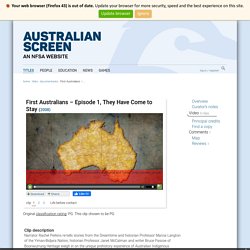
Marching together: world’s Indigenous peoples day in Sydney – in pictures. Australian governments have failed Indigenous peoples, says Oxfam. Successive Australian governments have failed to achieve meaningful change for Aboriginal and Torres Strait Islander peoples, according to a report by Oxfam that calls for a drastic overhaul of all areas of Indigenous policy and interaction with government.
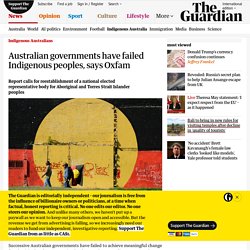
The report, released on Wednesday, outlines 10 recommendations including changing the native title system to make it easier to both attain and leverage as an economic and cultural asset; reestablishing a national elected representative body for Aboriginal and Torres Strait Islander peoples; changing the funding system to prioritise community-run Indigenous organisations; and implementing every relevant recommendation from every major report into Indigenous affairs in the past 30 years.
AIATSIS Language Map - Indigenous - Indigenous. Novelist Peter Carey Confronts Dark History In 'A Long Way From Home' In his latest book, A Long Way From Home, Australian novelist Peter Carey takes on his country's racist past, but he gets there by a circuitous route.
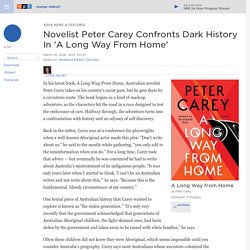
The book begins as a kind of madcap adventure, as the characters hit the road in a race designed to test the endurance of cars. Halfway through, the adventure turns into a confrontation with history and an odyssey of self discovery. Back in the 1980s, Carey was at a conference for playwrights when a well-known Aboriginal actor made this plea: "Don't write about us," he said to the mostly-white gathering, "you only add to the misinformation when you do. " For a long time, Carey took that advice — but eventually he was convinced he had to write about Australia's mistreatment of its indigenous people. "It was only years later when I started to think, 'I can't be an Australian writer and not write about this,'" he says. One brutal piece of Australian history that Carey wanted to explore is known as "the stolen generation.
" A find in Australia hints at very early human exit from Africa. As archaeologist Chris Clarkson was excavating a rock shelter in northern Australia one day in 2015, May Nango of the aboriginal Mirarr group brought her grandchildren to look at the pit. She pointed to a spot near the back wall of the red sandstone cliff and told the children that it was a wonderful place for their ancestors—the "old people"—to sleep 65,000 years ago, says Clarkson of the University of Queensland in Brisbane, Australia. Nango's tale was more than an aboriginal "dreamtime" story. Buried tools and pigments tell a new history of humans in Australia for 65,000 years. Indigenous Australians most ancient civilisation on Earth, DNA study confirms.
Australian Aborigines spent 50,000 years isolated from the rest of us. Australia, Papua New Guinea, and Tasmania made up one of the first regions modern humans reached after leaving Africa some 50,000 years ago.
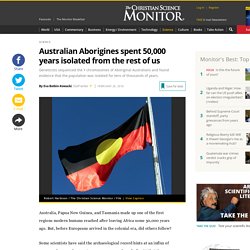
But, before Europeans arrived in the colonial era, did others follow? Foundation launches million-dollar plan to record Australia's songlines. Posted One to two Indigenous languages are being lost every year, say experts who estimate if the trend continues only 50 Indigenous languages will be left by the year 2050.
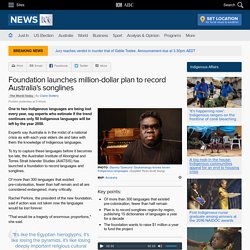
Key points: Of more than 300 languages that existed pre-colonisation, fewer than half remainPlan is to record songlines region-by-region, publishing 15 dictionaries of languages a year for a decadeThe foundation wants to raise $1 million a year to fund the project. NoongarPedia created as first Wikipedia site in Aboriginal language - RN. Updated In Noongar country, in the south-west of Western Australia, researchers are building the first Wikipedia site in an Aboriginal Australian language.
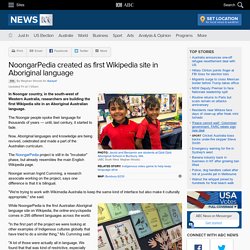
The Noongar people spoke their language for thousands of years — until, last century, it started to fade. Now, Aboriginal languages and knowledge are being revived, celebrated and made a part of the Australian curriculum. The NoongarPedia project is still in its "incubator" phase, but already resembles the main English Wikipedia page. Noongar woman Ingrid Cumming, a research associate working on the project, says one difference is that it is bilingual. "We're trying to work with Wikimedia Australia to keep the same kind of interface but also make it culturally appropriate," she said. Australia was colonized by a single group 50,000 years ago. There are two central mysteries about human history in Australia.
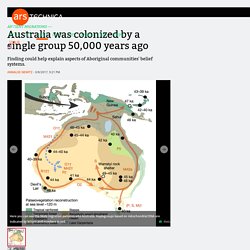
First, when did people arrive on the world's southernmost inhabitable continent? And second, how did they colonize it? A paper in Nature offers new answers, based on an extensive analysis of decades-old DNA. DNA Samples Reveal That Aboriginals Have Been in Australia For About 50,000 Years Already. The first people appeared in Australia about 50,000 years ago and Aboriginal people have been present in the same regions continuously since then. This was revealed by DNA in hair samples collected from Aboriginal people across Australia in the early to mid-1900s. These findings are the first detailed genetic map of Aboriginal Australia before the arrival of Europeans and confirm the Aboriginal communities’ strong connection to the country. The University of Adelaide’s Australian Centre for Ancient DNA (ACAD), in partnership with the South Australian Museum, has recently launched the Aboriginal Heritage Project and these are the first results from that study.
In a series of remarkable anthropological expeditions across Australia from 1928 to the 1970s, 111 hair samples were collected and these are now part of the South Australian Museum’s unparalleled collection of hair samples. Researchers analyzed mitochondrial DNA from these hair samples. Kaurna Elder, Mr. Save. Gallery: Aboriginal inventions. On this day: Pemulwuy is killed. ON 2 JUNE 1802, Pemulwuy was killed, bringing an abrupt end to his long- fought battles with encroaching British settlers. Two European colonisers shot dead the Indigenous resistance fighter – an original inhabitant of Toongabbie and Parramatta area, determined to Indigenous ownership of the land. Colonisers had begun to recognise Pemulwuy by his turned left eye, left clubbed foot and the agony of his spear, often decorated in red stone, which brought end to the life of one of Governor Phillip’s companions, John McIntyre.
Map recording massacres of Aboriginal clans has been released. A NEW MAP RECORDING the massacres of Aboriginal clans across the East Coast of Australia, also known as the Colonial Frontier, has been constructed by researchers from the University of Newcastle. With over 150 sites recorded, the map provides new insights into the scope of the massacres that occurred following the arrival of the First Fleet, as well as providing closure to Indigenous people from respective clans. Researchers say that they intend to add to the map over time as they continue to collate the oral histories of Indigenous people with settler accounts told through newspapers, court documents and letters.